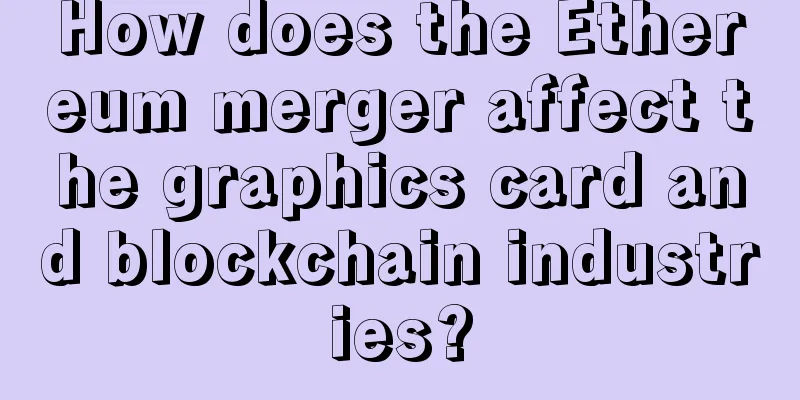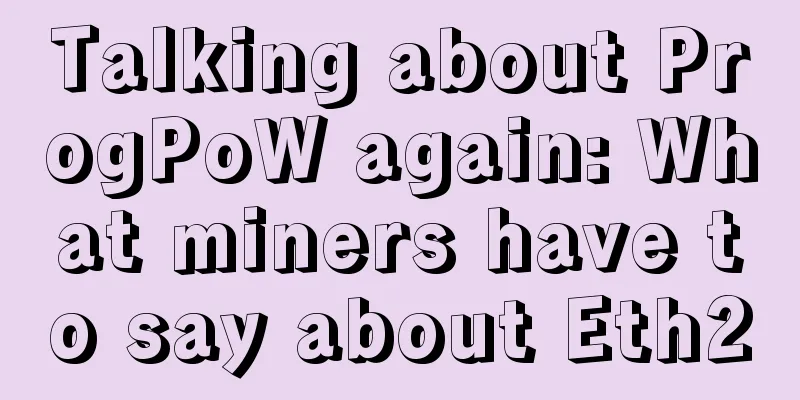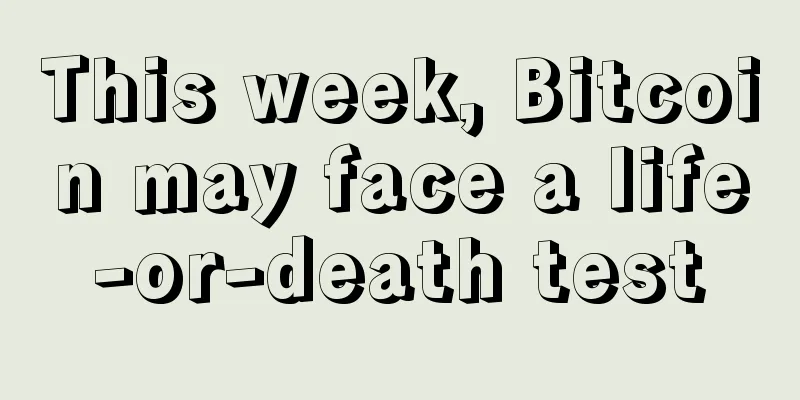How does the Ethereum merger affect the graphics card and blockchain industries?

|
introduction This article is a meeting record of the "Metaverse Insight First Exchange - The Impact of Ethereum Merger" on the evening of May 27. The meeting mainly discussed the impact of the ETH upgrade merger. host:
Panelists:
introduction: The Metaverse Insight series of events initiated by Guosheng Blockchain Research Institute will discuss with you the hot topics of the Metaverse and Web3 related tracks. Virtual people, NFT and other hot spots in the secondary market are actually product applications, which are inseparable from the important infrastructure-blockchain. Blockchain enables the creation of value transfer in the Metaverse, and the most successful public chain in the past few years is Ethereum. Recently, there have been many changes in the Ethereum industry ecology. From the surface, the price of graphics cards has fallen. On the one hand, the decline in currency prices affects the demand for mining machines. On the other hand, after ETH switches to PoS, the demand for mining will also decrease. Mining is only part of the impact of ETH merger and upgrade. So what are the difficulties encountered in the merger and upgrade process? What impact does the merger have on the ecology? What is the progress plan? ——This issue will discuss issues related to the Ethereum upgrade merger. 1. Difficulties and progress faced by ETH merge upgrade 1. Question: In fact, ETH started to talk about switching to PoS as early as 2017, but it has been repeatedly postponed. What is the difficulty? A: Actually, the merger and upgrade of ETH was proposed earlier. The white paper clearly mentioned the transition to PoS. However, the actual process was relatively long. It was not until October or November 2020 that the Ethereum roadmap was changed, and it was clearly stated that it would be transferred to PoS. The beacon chain was launched in December 2020. Recently, this matter has come to an end. The most optimistic time may be August, and my personal conservative estimate is that it is most likely to be October-December. Many media said that Ethereum was postponed. I think some media may not be professional enough in their interpretation. The media themselves did not expect the time to arrive, so they felt that it was delayed. This is the first problem. The second question is how difficult this is. My view is that the difficulty of things is changing at different stages of development. We define the period from 2015 to 2017 and 2018 as the early Ethereum. At that time, Ethereum faced three main problems: first, there were few applications on the entire network, and there were many things that wanted to be done, but the team had limited funds; second, there were few applications of practical value on the ETH chain, and there was no value; third, research required time and engineering investment, and there were members leaving the early development team. These difficulties slowed down the progress of early development. In the past one or two years, although the ecology has improved, the foundation has money, and there are more talents, there are many applications on the chain now, and the value of the assets on the chain may be hundreds of billions of dollars. Once there is any mistake in the upgrade and merger process, it will cause hundreds or thousands of times more serious consequences than in the early days. Therefore, the development team will be more cautious in promoting the merger and upgrade of ETH, which is also the reason why they adjusted the roadmap in October 2020. That time the roadmap was adjusted to simplify what needs to be done and turned it into a more executable plan. Specifically speaking, there are no particularly big technical difficulties. The key is how to coordinate the communication of such a large information network. Different development teams and different clients need to coordinate with each other. At the same time, some ecological partners, such as wallets, node service providers, exchanges, etc., need relatively smooth communication channels. Otherwise, the network may be fine, but the network interface may conflict. Therefore, sufficient testing and management of public expectations are required. These are relatively difficult areas, and they are also what the team has been working on recently. 2. Q: The Luna liquidation incident occurred some time ago, and market confidence is relatively fragile. Everyone is worried about what will happen if Ethereum has problems. If some such problems occur, what will be Ethereum's Plan B? Answer: The risks may come from two aspects. One is the risk in the conversion process, and the other is whether the so-called merged Ethereum is a very secure network. Let's not talk about the second one for now. The first question is: What are the risks during the period of transition from the current Ethereum to the merger? From the current test situation, the current merger plan is feasible in engineering, but there may still be problems in the actual conversion process. For example, the client bug, the test network is correct, but it does not mean that the main network is correct; the other is possible external attacks, such as hacker attacks or attacks by ecosystem stakeholders. At present, the foundation does not have a public Plan B, and the defense against external attacks may not be suitable for public disclosure, because public disclosure is equivalent to showing the trump card to the attacker. But I think in the current only test network upgrade and merger test, the team may do some drills recently. Referring to the previous Ethereum 2020 and 2021 client (including the mainstream client go-ethereum and another client open-ethereum) after the upgrade, Bugs occurred, causing the entire network to be out of sync for a period of time. Afterwards, the team made some incident reports. From the analysis of these reports, I think the foundation, mainly its client development team and security team, have learned a lot of lessons. Therefore, during the merger process, the security team, the client team, and some external security experts they hired should work closely to monitor the network status and respond as soon as possible. Judging from the current merger plan which is not too complicated, I think the possibility of problems arising cannot be said to be completely eliminated, but I believe they can be solved. 3. Q: The previous PoW mechanism relied on mining machines to support security and formed a closed loop. When the price fell below the starting price, many miners would be reluctant to sell, including the sales of mining machines would also decline. This mechanism would pull up the price when the coin price fell, playing a feedback role. After the transition to PoS, this mechanism disappeared. Will it have some impact on subsequent operations, ecology, etc.? A: Under PoS, when a node wants to withdraw, it may choose to withdraw, or it may unstake, or even use some financial instruments to fulfill its market expectations before unstaking. So I think this may be similar in operation, but the difference from mining machines is that mining machines have financial attributes, but they are not completely financial products like ETH. After ETH switches to PoS, it will not be supported by physical assets, and it will indeed be less stable than before, and the volatility may be greater. This is my opinion. It is difficult to analyze the actual market conditions at that time. 4. Question: For miners, a bigger problem they will encounter in the future is the difficulty bomb. The time to produce each block will be extended. When will the difficulty bomb be released in the future? Will it be synchronized with the merger? A: The Ethereum difficulty bomb has always existed. In fact, it has recently had an impact on the network. The average block time is now close to 14 seconds. If the difficulty bomb is not removed, it will increase by about one second every two weeks, or about two seconds a month. This is only the early stage, and the increase will be faster and faster later. Regarding the difficulty bomb and the merger, there are some points that I think need to be clarified. The relationship between the merger time and the difficulty bomb is not very large. In the earliest Ethereum 2.0 plan, the difficulty bomb was activated at that time, and 2.0 was gradually realized. But now the two are completely unrelated. In the new merger plan, the total difficulty is used to control the time to switch to the new consensus layer protocol. What is the use of the difficulty bomb now? According to the core developers, there are two main functions now. One is to put pressure on the core developers to deliver as soon as possible; the second is to interfere with the behavior of trying to fork the network. If there is no difficulty bomb, the original PoW can still be mined despite the merger. With the difficulty bomb, everyone has to modify the client code to negotiate a new PoW chain, otherwise there will be no way to produce blocks. And this code may want to be modified to look like A, and B may want to be modified to look like B, which increases the difficulty of negotiation and reduces the possibility of PoW. 5. Question: What are the subsequent upgrade directions you are optimistic about after the conversion? Answer: After the recent merger, Ethereum’s focus should still be on solving the scalability of the entire network. What people may mention more is sharding. Sharding will have a prerequisite protocol in the new plan, called EIP-4844 or danksharding, which describes a new type of transaction. Previously, there was only one type of Ethereum transaction, which was to initiate a transaction. This transaction could be executed, but some new requirements have emerged due to Rollup. EIP-4844 proposes a new type of transaction , which only carries some data to Ethereum. This data is used for communication between Rollup and Ethereum. There is no need to save the complete history, and it can be deleted after a period of time. At the same time, some zero-knowledge proof technologies are used to reduce the amount of data transmission. According to this proposal, if a good balance can be found, the scalability of Ethereum can be improved in this way. This is a relatively refreshing direction in recent years. Of course, this is not entirely Ethereum's own initiative, but it is trying in this direction. 6. Q: Sharding was actually mentioned in the Ethereum white paper in the early years, but later it was found that Layer2 seemed to have more advantages. Why is sharding so difficult to implement? If sharding is not an option, can Layer2 completely solve the problem? Q: First question, why is sharding difficult to implement? In fact, sharding itself is not a very new problem. It is a relatively common problem in distributed system computer databases. Therefore, the point is not that there is no good solution for sharding itself, but what impact will sharding have on Ethereum. If only a part of the global state of Ethereum is saved, the processing power requirements for a node can certainly be reduced. Although the amount that each node can process does not change, because it is only responsible for a part of the network system, the overall capacity of the entire system is improved. However, if Ethereum wants to shard the state, it means sacrificing the composability of Ethereum, which is precisely the foundation of Ethereum's prosperity. Composability means that between different applications on Ethereum, as long as the permission design allows, data can read each other and even operate on each other. Once the state is sharded, it means that node A stores some state data and node B stores some state data. If the application on A wants to use the data on B, it will face the problem of being unable to read the data. Of course, there are many solutions here, such as using some zero-knowledge proofs and similar cryptographic methods, which I will not elaborate on. The second question is that strictly speaking, Layer2 is not a capacity expansion solution in the general sense, but it will add more possibilities to Ethereum and the entire ecosystem. First of all, Layer2 certainly provides more state space, including more block space, and you can do transactions in each Layer2; at the same time, it has another advantage. Layer2, the underlying model of Ethereum's first-layer network, is actually difficult to make major changes. Each Layer2 may have its own practices, and these practices are in a state of competition. So sharding is something that Ethereum still needs to do, but it is difficult. Strictly speaking, we cannot discuss Layer2 and sharding together, but the problems they solve or the effects they can have are somewhat similar. 2. Staking services after ETH transfer to PoS 1. Question: After all, miners are also a large interest group. Will PoW fork out a new chain? A: I think the main reason here is that Ethereum has always emphasized the issue of legitimacy. From the perspective of miners, if mining is still carried out according to PoW after the merger, who is forking? This is the question of who is the orthodox of Ethereum. This is a value level or a disagreement on value recognition, so I will not discuss it in detail. Back to this question, forks are bound to happen, because even if there is only one machine executing the consensus according to the original network, it is a fork. But if there is only one machine, the impact can be ignored. So we should see whether there will be a more influential fork, at least as big as ETC. Back to October 2020, from what the foundation said and some previous exchanges, they were still very worried about the risk of forks. But a lot of things happened last year, which led to some opposing voices leaving the Ethereum community because they felt it was not worth their participation. After these voices left, most of the remaining miners just wanted to make money, so the risk of forks was unlikely to occur. It can also be seen from the recent graphics card prices that market expectations have been fulfilled in advance. Another thing is that the difficulty bomb will indeed cause some interference to the fork. Although it may only take a few lines of code to modify it, as mentioned earlier, A may have version A, and B may have version B. If everyone wants to fork a client of their own version, it is actually difficult to negotiate a consensus, so it is more difficult to gather a force of opposition. This is one of the reasons why the difficulty bomb exists now. In summary, I think the possibility of forking a new chain that will have an impact is very small. 2. Q: Compared with the current beacon chain revenue, if it becomes a full PoS chain, the mining revenue of PoS miners should double due to the addition of EVM Tips (tips) and MEV (bribe fees), and because of the decline in new supply and destruction, it may enter deflation, which are all good factors, so there will be a staking service track. But what is the threshold for service providers like Lido, and is there a moat? A: The business model of staking service itself is actually nothing new. Currently, there are other chains besides Ethereum, but the returns are not particularly high. So the opportunity brought by Ethereum may be that Ethereum is relatively large in scale. For service providers, it must reach a certain scale to have profit space. If the amount of your stake is relatively small, the profit is actually relatively weak, and may not even be enough to pay for security and brand-related investments. To prevent DDos attacks on the entire network, the cost is very high and it must be done all year round, otherwise the nodes will be at risk of being knocked offline, so the service provider must have a sufficient amount of pledged funds to achieve profitability. So how can we have enough pledges? This is more like a brand business. First, you need goodwill, and second, you need social relationships. This social relationship may be whether the service provider is an institutional investor, that is, directly participating in primary market investment and operating or investing in a pledge service provider. The service providers I have seen at home and abroad, except Lido, may all follow this model. Another relatively large participant is the exchange. We see that Lido currently accounts for about 33%. The second and third places are actually two exchanges, one is Kraken and the other is Coinbase. 3. Question: Under PoS, users lock up their ETH in order to obtain more ETH, and the selling pressure is reduced. This will make people use Defi more. So will this direction be bad for developers and investors in the ecosystem, but more beneficial to investment users? A: The recent Luna incident shows that the pure staking model is definitely unstable. So the value of Ethereum is not due to transactions, but because of the real value generated. This real value lies in the fact that it provides some block space. Users must use Ethereum to pay for block space usage fees, which is a bit like the block space collecting taxes from users. In some extreme cases, this space must even be auctioned, because in addition to ordinary users, there are also a large number of arbitrageurs among Ethereum users. There may be an arbitrage opportunity on the chain, worth 10 million US dollars, and arbitrageurs may even be willing to spend millions of US dollars in handling fees to obtain this arbitrage opportunity. The game here involves price or value, which is relatively complicated. Reducing selling pressure is only one factor, and there may be other factors to consider. The first is that Ethereum’s monetary policy will become more unstable after the merger. A stable monetary policy, like Bitcoin, reduces the output of each block by 50% on average every four years. This is a relatively stable and predictable monetary policy. But Ethereum is unstable in several ways after the merger: First, the annual inflation rate is related to the number of stakers. The number of stakers may increase or decrease. Since withdrawal is not allowed before the Ethereum merger, it will only increase in one direction. However, it is difficult to determine the number after withdrawal is allowed. Therefore, the inflation rate itself is highly unstable and may vary between 1% and 10%. Second, after the introduction of EIP-1559, a portion of each transaction will be destroyed, and the destruction rate is also uncertain. More will be destroyed when the network is busy, and less will be destroyed when the network is not busy. Therefore, I personally do not think that deflation is a good expectation, but unstable monetary policy will bring some risks, because we actually have no way to make some good predictions about the future state of the network. This is my personal opinion. The second is network security. Next, Lido has a market share of about 32%, close to one-third, and the top three staking service providers account for more than 55%. When Ethereum first appeared in the POW mining pool, the computing power distribution was still quite scattered, and no one exceeded 20%. Now the top three have exceeded 55%. As various exchanges may join in the future, this proportion is expected to rise. Will the power of the network become more and more concentrated, and will it affect people's trust in Ethereum? I think it will. In addition to the trust level, the security at the factual level will indeed cause some threats, such as a single service provider, which may be invaded. Like Lido or the exchange, the service method he adopts or his computer room is attacked, which will cause some risks. The risk is concentrated, which is the second point. In fact, before ETH2.0, a service provider Stakehound had a security incident, and they may have lost more than 80,000 ethers. The third one is MEV. To put it simply, MEV means that block producers, such as miners or validators, have the right to choose which transactions to package into blocks and sort them. By changing the order and choosing who to choose and who not to choose, the block producer can make some profit. This is a bit like front-running trading in traditional securities trading. After PoS, the impact of MEV may be magnified. Because under PoW, it is unpredictable who will produce the next block. Even if the mining pool has 30% of the computing power, it is not known whether the next block will be produced by the mining pool. It is completely random. But now in the POS scheme, the order of blocks can be known in advance, so there is more time to screen and sort these transactions, and even to conspire and conduct cross-block arbitrage with the previous block producer. Of course, Ethereum has recently tried to solve this problem through some protocols, such as SSLE, a secret block producer selection protocol. If Ethereum cannot reduce this risk in the protocol, some applications and some arbitrageurs may go to other chains, which in turn will affect the ecological value of Ethereum. So I think after the merger, there are three points. The first is unstable monetary policy, the second is network security, and the third is that MEV may cause some relatively negative impacts. Of course, there will be some positive impacts, such as the decline in selling pressure, the overall economic model tending to be closer to a deflationary state, and more capital may prefer a model because such an investment product is more likely to be liked by financial people. After all, miners have a physical asset there, and their financialization capabilities are weaker. 3. Layer 2, Sharding and Public Chain Development 1. Question: If Layer2 becomes bigger, will the transition from Layer2 to sharding be like the current transition from PoW to PoS, which also requires some pain or time to make the transition? Or if Layer2 becomes bigger and does well, will the subsequent sharding research and development not be as fast as imagined, or even new solutions may come out? A: Currently, the problems that Rollup can solve are similar to those solved by Ethereum. Applications can be written on it, transactions can be issued, and these applications can access each other. At this stage, as the number of users increases, the Rollup fee will also increase. The current Arbitrum network will also be quite expensive in the future. The second problem is that Rollup will also face the problem of MEV, including the problem of Layer2 activity. If there is only one or a few nodes on the chain responsible for packaging and uploading, and these nodes are attacked or the network has problems, its activity will also be affected. Activity problems are a big attack. For example, if transactions cannot be submitted to the chain for 5 or 10 minutes, the price may change greatly and the collateral may be gone. So the problems faced by Layer2 are the same, but it has not yet developed to that stage. So conversely, sharding is definitely what Ethereum will do in the long run. What is the advantage of Layer2? The cost of trial and error is lower. Each Layer2 has its own implementation plan, whether it is language, design, consensus protocol, or economic design, and different attempts can be made. Ethereum can also learn from it. In addition, I personally think that the current Layer2 is seriously bubbled, and the valuation of each company is relatively high. I am not familiar with the capital market, but from my personal judgment, this bubble has begun to appear. 2. Question: At present, the scheme for sorting miners has not actually changed in PoW and PoS. Whether MEV brings advantages or troubles to the system is still controversial. Is it possible that a new scheme will come out in the future? A: First of all, this problem will be more serious after PoS than PoW. The reason has just been mentioned, because its block generation order is predictable. Let's take another example. For example, if I wrote a Dapp to draw a prize when the block height reaches a certain level, I can know in advance that I packaged the transaction for this prize-drawing block. I can sell this block before the prize-drawing because I have the rights to the prize-drawing. People who buy the block can try to win the prize in it. So this problem will be more serious after PoS. Of course, there are some new solutions like this recently, trying to solve this problem. Is there any way to solve the second problem? Simply put, there are two paths. The first path is similar to the private pool solution. A private pool refers to a service provided by a mining pool or a future pledge service provider, which promises to submit transactions but will not broadcast them to the network, so that the transaction will not be preempted. This is a private solution, which ensures that the transaction is directly included in the block and will not be broadcast on the network. If it is not broadcast, it will naturally not be preempted. Another solution is made by the flashbots team. They have done a lot of research on MEV. Sometimes the block space is very expensive because there may be two or three people competing for an arbitrage opportunity, which will increase the base of the entire block's handling fee. The general idea of the Flashbots solution is that there may be more than a hundred transactions in a block. I will allow you to bid privately for one or two transactions. Whoever bids the highest will put it in the desired position, and let everyone grab the rest. Judging from the current operation results, it has some effect. 3. Q: After sharding, if the communication is not done well, it will still have a certain negative impact on the basic performance of the network. Polkadot generally looks like it has done a lot of sharding, but these shards are heterogeneous, and each parallel chain does something suitable. I would like to ask about the comparison between Polkadot's architecture and sharding? A: Polkadot hopes to implement a specific business in each of its own parallel chains, and different parallel chains can communicate through some relay chains. Such a design assumes that there will be something like an application chain . The success of Ethereum lies in the unlimited call of status. Each application can access the status of other applications, which increases a lot of combinability. It has established a relatively smooth innovation possibility between different protocols. Polkadot is more like I want to do something, so I will do it here, and then see if everyone can cooperate with it. I think there will still be some differences in the overall design concept. This may be suitable for different scenarios , but I may not understand it very much. 4. Question: Polygon relies on the development of the original public chain and leverages its power. So after leaving, will it become a free chain that develops independently from Ethereum? A: Polygon is slightly different from Layer2, because Polygon itself is a chain, but it is bridged to Ethereum. For example, Layer2 such as Arbitrum or zkSync Link cannot be a complete chain at present. Is it possible for Layer2 to leave in the future? First of all, the chain is a relatively complex concept. It needs to consider security, build users, and integrate with many different ecological components: wallets, browsers, network service providers, security service providers, etc. It is a very difficult thing to build. But Layer2 has to do this. This is not an economic consideration, because economically, leaving Ethereum actually feels like a confrontation. But from the perspective of security, I think it must be prepared, because once Ethereum itself has some security problems, it may cause some blows to Layer2. For example, if Ethereum has a very long reorganization, it will destroy the foundation of many Layer2 security pricing, and many transactions on it will have to be reversed, which will cause a lot of huge impacts. So Layer2 must make these preparations, but I don’t think they will actively try to escape from the Ethereum chain and develop independently in the short term. 5. Q: Some applications on Ethereum, including MakerDAO, are actually being copied to the Solana chain. Users don’t seem to care so much about centralization, and there are not so many nodes. Even if they crash, they can just restart. Once Ethereum switches from PoW to PoS, it will be a staking mechanism. What will the competition among public chains be like at this time? A: First of all, there may be some differences between PoS and PoS. Ethereum's PoS is a real PoS, and you have the opportunity to generate blocks by staking, but BSC is relatively simplified. It is equivalent to a delegated DPoS, which requires you to vote for others and cannot generate blocks by yourself. The security difference is quite large. Generally speaking, Ethereum is more reliable and definitely better in terms of security. I think Solana is also a similar DPoS method. Because real PoS is very difficult to do, this is the first point. The second point is whether users care about decentralization and whether capital cares about the price impact caused by high pledge rates. First of all, the world is diverse and users are also stratified, so everyone will choose the place they prefer to go. Some people like to go to places with high risks, and some people like to go to safer places. Secondly, there is a big difference in developing applications on it. Many things on Ethereum have grown spontaneously. Many applications on it may be done by a very small team at the beginning, without financing, and non-profit. They gradually grow bigger. A typical example is ENS . There are also some projects that seem to be public welfare projects, but they have embedded these things into the Ethereum ecosystem for a long time. The application development model of other public chains is more like a foundation transfusion model. The foundation incubates some teams or funds some developers. Whatever is on Ethereum, they copy it. This is more of an idea. First of all, there is definitely a difference in innovation. What is the second question? The enthusiasm of developers, including their sense of mission, also makes a big difference. A big advantage of the Ethereum community is that the people there are very interesting. We are willing to communicate with them, not just about the things brought by the chain system. I am talking about some of my observations from the perspective of practitioners. Users may not care much about this. Users may just go to whichever side is more useful. Everyone knows what the risks are and what the benefits are. Capital definitely prefers the foundation model. First, it has greater control, and second, it has a better expectation for the development of the entire project. In many things on Ethereum, people still pay more attention to procedural justice or democracy. In many cases, people will have a lot of big debates or long debates on a problem. If the capital side wants to incubate a project, it may require it to be completed within a month. There is a big difference in community culture. This is also one of the reasons why many people still like Ethereum. From the current perspective, the source of several milestone innovations still comes from Ethereum, including the earliest Dapp, and later DeFi and NFT, which are all phenomenal things. But in the next era, including people paying more attention to application-level things, for example, after Axie came out, everyone found that this game was also very good, and it in turn incubated the public chain. In fact, as early as the bull market in 2017, a public chain would invest in an exchange, and the exchange would set up an investment department, establishing such a triangular state of mutual diversion. Now, we see that an application can incubate a public chain in turn, and the public chain will actually form an investment department. This is actually the originality of Ethereum is still relatively strong. 6. Question: If you look at Web3 at this stage, from a bottom-level perspective, which three directions are you more concerned about? A: First of all, privacy . I recently saw that W3C has also issued a privacy practice principle, which has some guiding significance. This is the first point. Because in Ethereum, most people's data is actually naked, which actually has many security risks. People may not realize it now. For example, ENS is your name, or even your phone number. He bought something very expensive. I really don't think this is an operation worth learning from. It may cause some trouble. So privacy will definitely be an issue that everyone will pay attention to next, and it may take a long time to produce a mature solution. The second is personal identity DID. Everyone who enters this network must have an identity to interact with different networks. This is also a very important field, but it is not clear whether it is a protocol, a product, or something else. There are also many teams working on this area. In addition, there is zero-knowledge proof , which may have some overlap with the privacy mentioned earlier. Zero-knowledge proof technology itself can be used in many places, so it cannot be called a track. Zero-knowledge proof can be used to do many things, and its academic and engineering progress are all rapid. I first came into contact with this technology about ten years ago, when it was basically unusable, but with the advent of blockchain, zero-knowledge proof has become a very useful weapon, so it is very useful to keep paying attention to it for a long time to come. |
<<: STEPN clears mainland users: Implementing GPS technology to prevent cheating is inevitable
>>: Wu said-Weekly mining information 0523-0529
Recommend
Shenyu: Who is buying mining machines at 70 yuan per kilogram?
The news of "mining machines being sold by w...
People with these palm lines have smooth careers.
1. People with straight and deep career lines The...
What is the fortune of children with big foreheads?
We all know that if an adult has a big forehead, ...
Malicious mining programs are rampant, and many government websites have been hacked
Hardly a week goes by without a report about mali...
If you want to marry a rich man, here are some tips on how to tell if a man is rich.
Basically every woman hopes to marry a rich man s...
What is the personality of a man with a knotty nose? He only thinks about himself in everything!
Will a man get divorced if he has a knotty nose? ...
Why does KOL financing exist? Why is the controversy growing?
“Key opinion leaders” (KOLs) use their influence ...
What palmistry features mean you will get a windfall?
There are many ways to accumulate wealth. Most pe...
Men's palm reading
Nowadays, if people don’t earn much, can’t keep t...
Do people with low Shan Gen have bad luck? What does a low Shan Gen mean?
People with low Shan Gen are prone to disasters. ...
If the career line rises from the wisdom line, people will be lucky when they reach middle age!
How to read the career line diagram on palmistry?...
The five facial features of "Savage Girlfriend"!
In the movie "My Sassy Girl", the rude ...
Will ear piercing ruin your appearance? How to fix ear piercing?
Big earlobes are a sign of a person's good fo...
Do people with short philtrums and bad moles not value filial piety?
Our country's physiognomy involves very far-r...
Gold bulls change their attitude! "New Bond King": Bitcoin may be better than gold
Jeffrey Gundlach, CEO of DoubleLine Capital and t...









